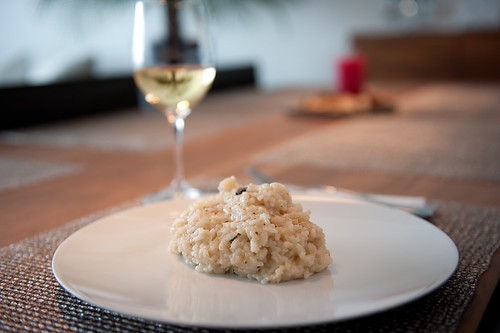This recipe is designed to make your life easier. It’s for risotto. No, really – don’t walk away.
Risotto is a comfort food. Nigel Slater referred to it as “the most gently restoring of all suppers.” For a dish that’s high in carbohydrates, flavor, warmth and, depending upon how you make it, fat, it would be hard not to respond kindly to it. And yet, it’s rarely thought of as a comfort to cook. This shouldn’t be. A thoroughly delicious risotto is as simple to prepare as a good pasta or soup.
That home cooks have been scared off of risotto is not their fault. Most cookbooks paint a frightful, extended picture of preparing risotto that reads something like: Stir. Add expensive ingredients. Stir until your brow is beaded in sweat, your shirt is stained and your guests thoroughly bored. Then keep stirring.
It doesn’t have to be that way. The mandate of stirring risotto is a myth.
A few days ago I had a friend over for dinner. When I stirred my risotto was determined not by the recipe’s regime, but by the rhythm of our conversation. Translated into a recipe, it would read something like: Stir. Talk. Drink. Examine the garden. Stir. Drink again.
Consider that risotto begins the same as a soup: with a base of onions (or shallots) and garlic browned in butter and oil in a pan. From here, all a proper risotto requires is some initial stirring, followed by the stirring in of stock (or water) every few minutes. All in all, it takes 30 minutes. You can do it in less. ”You can cook it in 10 minutes if it’s at full whack,” Jamie Oliver told the NY Times. ”But it’ll be done on the outside and like gruel inside.”
Risotto is also a remarkably flexible and forgiving dish. It can be as humble, as unusual or as elegant as you want it to be. Because of its absorptive properties, it conveys flavors remarkably well. Short of burning the rice, it’s also remarkably difficult to mess up. Risotto can be as soupy as melted ice cream, or as dry as a thick coconut rice.
That’s not to say that there aren’t a few important things to keep in mind. Here are a few suggestions.
Start with a good base. Like a soup, your base flavors can significantly enhance your risotto. Make sure to brown the onions (or shallots) and garlic well, but avoid burning them. In vegetarian risottos I’ve also added celery, and found it to impart some welcome additional substance.
Stock. Don’t feel trapped into using stock. As Mark Bittman wrote, you just don’t need it. But this is specific to recipes in which you plan to use flavorful solid ingredients, from which the water you add will naturally draw flavor and impart to the rest of the risotto. Whether it’s stock or water, make sure it’s hot. A tea kettle of recently boiled water works fine. If you prep vegetables in water — by blanching, or reconstituting them — consider keeping that water as your base stock. Otherwise, you’d simply be throwing out flavor. (Note: My friend Rob does this by soaking mushrooms, and swears by it.)
Butter & wine. Don’t skimp on it at the start, and don’t hesitate to add it at the very end. Also a liberal dosing of white wine at the beginning. This is comfort food, remember?
Consistency. A risotto can piled thick and sticky on a plate or served slightly soupy in a bowl. This is purely a matter of personal taste, of course, but for what it’s worth Mario Batali favors the latter approach.
Cheese. A generous helping of freshly grated parmesan is always welcome, but if your ingredients are strong in flavor, don’t waste good cheese whose flavor will be lost.
Ready for some recipes then?
Here’s a good one from Nigella Lawson. Here’s a pumpkin, sage and bacon risotto from Jamie Oliver. And here’s a version of the one I made, slightly adapted from Mario Batali and Mark Bittman.
Recipe: Risible Risotto
1 pound asparagus, cut into one-inch-long pieces.
4 to 6 cups chicken or vegetable stock
2 tablespoons extra virgin olive oil
3 tablespoons butter
1/2 medium onion, diced. Or a few shallots.
3 cloves garlic, diced.
2 celery stalks, diced.
1 1/2 cups Arborio rice
1/2 cup white wine
Salt to taste
1/2 cup grated Parmesan cheese.
1. Blanch the asparagus for 5 minutes in boiling water in a pot. Remove asparagus and run under cold water. Reserve water used to blanch asparagus and mix with your chosen stock. Cover and keep hot on a back burner.
2. Place a large saucepan over medium heat, and add olive oil, half the butter, shallots, celery and garlic. Mix in pan until browned.
3. Increase heat to medium high and add rice. Stir occasionally for 2 to 3 minutes. Then add wine, stir and let bubble until it is absorbed, 1 to 2 minutes. Add a large pinch of salt and some ground pepper.
4. Add warmed stock or water, 1/2 cup or so at a time. Stir to mix and scrape the bottom of the pan. Each time stock has just about evaporated, add more.
5. Check to make sure you’re drinking and talking enough. How’s the garden look?
6. After about 15 minutes of adding stock, add asparagus pieces and tips, continuing to add stock when necessary. In 5 minutes, begin tasting rice. You want it to be tender but with a bit of crunch; it could take as long as 30 minutes total to reach this stage.
7. When it does, remove skillet from heat, add remaining butter and stir briskly. Add Parmesan and stir briskly, then taste and adjust seasoning. Risotto should be slightly soupy. Top with parsley. Serve immediately.
Yield: 3 to 4 servings.
Cook time: 20 – 30 min
Prep: 10 min
Source: Originally published in The Oxford’s Omnivore, October, 23, 2009.

